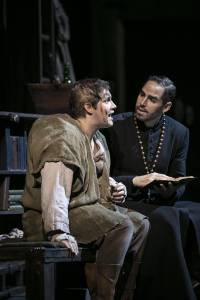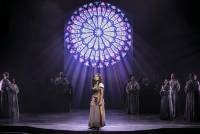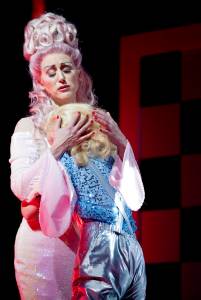28.01.2020 - Malmö Stadsteater (Schweden)
HEDWIG AND THE ANGRY INCH
Do soulmates exist? And if they do, how much is one willing to sacrifice to find them? For Hedwig the search for her lost half has dominated almost her entire life. Born as Hansel in East Berlin during the Cold War, she flees with an American soldier to the USA - and thus becomes Hedwig. But Hedwig still has a lot of obstacles to overcome until her journey to find love is over.
This is the basic premise in HEDWIG AND THE ANGRY INCH by John Cameron Mitchell and Stephen Trask, which has opened in Malmö Stadsteater on January 16th. Though a musical, it feels much more like a concert with Hedwig telling her life story.
An important theme of the show is dualism which it also deconstructs. Hedwig herself reflects that with her being neither a man nor a woman. In addition, her personality is just as polarising, hard to grasp but understandable at the same time. Lindy Larsson gives an outstanding performance: One gets his Hedwig instantly, yet she still surprises. His Hedwig is as changeable and divided as her birth place, the then divided Berlin. She can be sweet, naïve and almost childlike, but also vicious and downright cruel. She is flawed and incredibly human.
There is probably nothing that can surprise Larsson. He improvises with ease, comments and builds upon what is happening in the auditorium and connects with all audience members. And if you think you’re safe in the back rows, think again, because Hedwig will come to you - only if she wants of course.
The theatre was ideal. Though it’s quite large, it still captures the intimate concert mood that differentiates Hedwig from other musicals. But this is also due to Larsson’s effort. He really looks into the auditorium and his gaze probably lands on everybody during the course of the show.
The scenography (by Annika Bromberg who also designed the costumes) is minimalistic, but this also fits the concert image. Therefore the staging doesn’t change that much – unless certain characters destroy it. The projections stand out even more because of that. The gummy bears with the glowing eyes during “Sugar Daddy” are just one example how they can be both humorous and frightening.
Though it is mostly Hedwig’s show and story, she is far from alone. By her side is her husband Yitzak. It can’t be easy to compete with Larssons stage presence, but Mari Götesdotter manages. She gets the audience easily on her side and animates them to applaud loudly or even to sing along. With Larsson and Götesdotter they also found the perfect duo: They complement each other acting and singing wise. The final song “Midnight Radio” especially stands out as especially touching. Both seem so vulnerable and yet strong, hurt and yet happy.
The band members play an essential part as well and they more than deserve a shout-out. They bring the music to life, creating the rock atmosphere and their reactions to what’s happening on stage are also fun to watch.
The musical is performed without a break, and it cannot be an easy feat portraying such intense parts (both physically and emotionally) for about 80 minutes. But everybody keeps the energy up and stays perfectly in character from start to finish. The audience as well never leaves Hedwig’s story until all is told. And before you know it, the musical’s already over. And through all the destruction and the hurt, both Hedwig and Yitzak finally come to accept themselves and each other.
The late 90’s or the early 2020’s, Broadway or Malmö, HEDWIG AND THE ANGRY INCH mesmerises and captures audiences all over the world. This production under the direction of Dritëro Kasapi perfectly balances humour and emotions to create an entertaining evening that is both musically and story wise more than satisfying,
You can experience Hedwig for yourself in her “one night only” performance in Malmö Stadsteater until February 29th. After that HEDWIG AND THE ANGRY INCH is going on tour, making stops all over Sweden.
Bewertung 5/6:
★★★★★
© Kritik: Lisa A. Murauer © Fotos: Mats Bäcker
04.10.2018 - GöteborgsOperan, Schweden
RINGAREN I NOTRE DAME - MUSIKALEN
Since September 22nd the bells of Notre Dame can be heard in all of Gothenburg. RINGAREN I NOTRE DAME ("The Hunchback of Notre Dame”) has taken the stage in GöteborgsOperan under the direction of Thomas Agerholm.
The story incorporates elements from both the Disney movie and the original novel by Victor Hugo. It follows Quasimodo who, since he was born deformed, lives hidden in Notre Dame. Raised far from the world, his only company is the archdeacon Claude Frollo. One day, Quasimodo goes against Frollo’s directions and decides to leave his home, where he meets the gypsy dancer Esmeralda. The two quickly form a close friendship, bonding over their similar life as an outcast. Meanwhile, becoming more and more infatuated with Esmeralda, Frollo wishes to win her for himself or – if she refuses – to destroy her completely. With the whole city of Paris against them, only Quasimodo can save Esmeralda from her fate.
The music by Alan Menken with text by Stephen Schwartz includes songs from the animated movie as well as new compositions. The tunes instantly evoke an imposing atmosphere using the choir and take the audience into the epic story. In addition to sounding gorgeous, the use of the choir fits the medieval setting and the religious themes perfectly.
Martin Redhe Nord plays the bell ringer with a pure and almost childlike innocence. Quasimodo’s desire to be among the people – even if just for one day – is expressed in "Där ute" ("Out there"), with a stunning performance by Martin Redhe Nord. Quasimodo’s feelings for Esmeralda are also portrayed in such a way that the audience just has to empathise with him. One of the most heart-warming moments is the song "Ovanifrån" ("Top of the World"), where Quasimodo shows Emseralda the view from his tower, displaying the blossoming relationship the two form.
Marsha Songcome portrays Esmeralda’s strong spirit with great credibility. Her Emserlda is bold and dares to speak up – even to god. In "Se dina minsta" ("God Help the Outcast") she even commands God to aid the people needing his help in, depicting her authority. Despite her braveness, Esmeralda is truly afraid of the gruesome fate she is confronted with. This fear is also clearly shown by Marsha Songcome, making Esmeralda both strong and frail at the same time, letting one wish for her to escape her impending doom.
Emseralda’s dance manages to mesmerize not only the three main guys, but the audience as well. Marsha Songcome’s movements are light and powerful at the same time, her Esmeralda has some kind of energy not unlike a raging fire. The choreography by Lynne Kurdziel Formato is simlpy stunning, full of life and it enthralls the viewers.
Despite playing the role of the villain, Joa Helgesson gives Claude Frollo depths that make it possible to feel with him, even take pity on him, albeit Frollo’s gruesome deeds. Frollo is not portrayed as an inhuman, wicked being. In the beginning, as he treats Quasimodo with kindness, one can see that he is not a bad person, but throughout the musical some form of madness takes more and more hold of Frollo. That madness and Frollo’s inner struggle are emphasised in "Elden" ("Hellfire"), in which Joa Helgesson also proves his vocal talent. The finale of "Elden" couldn’t be any more spectatcular. It just takes ones' breath away, when the projected image of Notre Dame gets immersed in fire and the whole auditorium begins to tremble. Nothing akin to that moment exists.
Speaking of which: One highlight of the musical has to be the staging. The Swedish production uses one similar to the Danish one – why should you change something that perfect? – and Benjamin la Cour has once again used his magic to captivate the audience. The theatre shakes as the stage seemingly moves from the church hall to Quasimodo’s bell tower. Sound (by Andreas Renhorn), video (by Jakob Bønsdorff Eriksen) and vibrations all work together to create a special theatrical experience. It just feels purely magical.
At first glance, the soldier Phoebus De Martin seems to be a shallow man who only wants to take delight in the company of any woman he meets. However, thanks to Esmeralda’s influence he becomes more and more selfless and stands up for what’s right – even if that demands sacrifices. Jonas Eskil Brehmer gives his performance enough credibility that one can easily believe Phoebus’ change. He also manages to depict Phoebus’ inner struggle with a similar truthfulness. Though Phoebus has already lived through a hellish war and wants nothing more than to keep his newfound peaceful life, he willingly puts himself in danger for Esmeralda’s sake. Jonas Eskil Brehmer also shows great chemistry with Marsha Singcomes Esmeralda, both their duets are a joy to listen to.
The gypsies’ king Clopin possesses many sides: In one moment he is nothing more than a mischievous thief and amuses his audience, the next he emits a menacing aura, vowing to kill anyone who dares to put the lives of his people in danger. Tobias Ahlsell does a great job in portraying all of Clopin’s facets.
Even though the musical is grimmer than the animated movie, there are still moments that make one laugh. One of them is the rather short but memorable scene involving the French king Louis XI. portrayed by Magnus Lundgren. Frollo seeks the king’s help in catching Esmeralda and while that shouldn’t be as funny as it is, Magnus Lundgren reacts in an overdramatic fearful manner that one can’t help but burst into laughter.
The costumes by Anna Juul Holm and Lotte Blichfeldt are well done – fitting both setting and characters – and help the audience identify the ensemble’s roles during the musical. There are also changes in costume throughout the show which are beautifully staged.
The rest of the enormous ensemble impresses with a stunning performance. The actors take up many distinct roles – sometimes acting as narrators and characters in the same scene – and portray all of them with passion and authenticity. The ensemble’s vocal ability especially shines in the choir passages, evoking a churchlike atmosphere. Worthy of mention is the second act’s overture that incorporates the different musical themes into a stunning piece sending shivers down one’s spine.
This production also offers the possibility to sit on stage, where the ensemble sometimes sits right next to you. These church-like seats even move around, so one can look into the audience from the actors’ point of view. While there are some passages one can’t fully see, others are shown in a different way, making this musical certainly worth another visit.
As soon as the curtain falls, the viewers jumps up from their seats, bringing the ensemble back on stage again and again through their standing ovations.
Nobody should miss this production! It is theatre at its best with a magic one has to experience for oneself. Though the musical is performed in Swedish, it doesn’t matter if one can’t understand every word. The emotions can be felt regardless, proving that musical theatre is a language of its own.
RINGAREN I NOTRE DAME playing now in GöteborgsOperan in Gothenburg until April 6th 2019!
Bewertung 6/6:
★★★★★★
© Kritik: Lisa A. Murauer © Fotos: Mats Bäcker
16.02.2018 - Malmö (Schweden)
PIPPIN
The musical PIPPIN by Roger O. Hirson with music by Stephen Schwartz, first performed in 1972 on Broadway, celebrated its premiere in Sweden at the Malmö Opera on January 27th 2018.
Directed by Ronny Danielsson the musical tells the story of the titular character Pippin (Oscar Pierrou Lindén), the restless son of Charlemagne (Michael Jansson), searching for his place in the world and for the meaning of his life. On that journey he is accompanied by the Leading Player (Lindy Larsson), an enigmatic figure acting as the storyteller. Whatever Pippin tries, nothing seems to give his life any meaning, be it taking part in the war of his father or his love affair with Catherine (Åsa Fång).
In the grand finale, the Leading Player tries to seduce Pippin into committing suicide by setting himself on fire, since it is the finale that gives the life its true meaning. As Pippin refuses, the furious Leading Player leaves the stage, after taking away all theatre ‘magic’. The musical ends with Catherine’s son Theo alone on stage singing “Theos Himmel” (“Corner of the Sky – Reprise”) without an orchestra – performed beautifully by Ruben Vaarning in that performance on Sunday February 11th.
Oscar Pierrou Lindén plays Pippin. His voice gives his performance a heart-warming, often touching aspect, especially apparent in “Himlen” (“Corner of the Sky”). Though Pippin himself with his questionable actions isn’t or shouldn’t be the most sympathetic character, Lindén manages to stay likeable throughout the play.
Pippin’s everyday-like outfit stands in stark contrast to the opulent flashy costumes of the other cast members, marking him visibly different and less glamourous. Fitting, since he is the one searching for his place in the world. Compliments to Camilla Thulin for designing these costumes.
Right from the start Lindy Larsson as the Leading Player captivates as he leads the audience into the magical world of the musical in “Den Magi Som Ni Ser” (“Magic To Do”). Larsson possesses the perfect stage presence for the part, even when he is in the background, that presence can be felt. Charming, but with dangerous and cunning undertones his Leading Player is not unlike a devil, seducing and manipulating Pippin throughout the musical. His relationship with Pippin and his feelings for him are ambiguous, he seems to care about him in some way and near the end he seems to be truly hurt by Pippins actions and rejection.
Åsa Fång gives a likeable Catherine and loving mother to Theo (Oliver Palm, Ruben Vaarning or Melker Wickenberg). Her courting of Pippin by imitating the cry of a seal-like animal is one of the funniest moments in the musical. The love duet “Om Kärlek” (“Love Song”) gives both Fång and Lindén the opportunity to show their talent as well as their chemistry with each other.
Interactions with the audience is one of PIPPIN’s defining aspects. Apart from Larsson it is Johannes Wanselow as Pippin’s grandmother Berthe who interacts with the audience the most, even encouraging them to sing along in “Tid Att Ta Din Tid” (“No Time at All”). That song is also remembered for Wanselow’s entertaining use of a Segway.
Charlemagne, the power-hungry king is played by Michael Jansson. It’s impressive how fast Jansson can speak and sing, shown in “Krig Kräver Kunskap” (“War Is a Science”), also featuring an impressive choreography by Roger Lybek. The choreography with its use of breathtaking acrobatics adds to the circus atmosphere of the show as well.
Pippin’s half-brother Louis played by Kitty Chan is self-loving and feisty. That arrogance is perfectly and hysterically portrayed by her. Louis’ mother Fastrada depicted by Nina Pressing makes it clear that her loyalties lie with her son. Using Pippin and willing to betray her husband that ruthlessness is particularly evident in “Sprida Lite Solsken” (“Spread a Little Sunshine”).
The stage designed by Martin Chocholousek is adaptable, taking the audience into a church or to the cannels of Venice. The orchestra isn’t hidden in the orchestra pit but present on the stage and in some songs individual musicians come to the front of the stage.
PIPPIN with its absurd comedic elements promises an entertaining evening. The Swedish production delivers, with its hilarious ideas – enormous inflatable ducks or a headless soldier, stumbling around the stage combined with his talking head – and outstanding performance of the cast.
PIPPIN now playing at the Malmö Opera until April 21st!
© Kritik: Lisa A. Murauer, © Fotos: Malin Arnesson
08.01.2018 - "Det Norske Teatret", Oslo (Norwegen)
THE BOOK OF MORMON
“The Book of Mormon” created by Trey Parker, Robert Lopez and Matt Stone is definitely not a musical for the whole family. Violence, profanities and sexual themes are used throughout the show. Despite – or maybe because of the higher rating – the musical is a Broadway and West End hit and has now travelled to Norway. “The Book of Mormon” directed by Vidar Magnussen opened in Oslo’s Det Norske Teatret on September 2 nd.
The musical starts innocent enough as a light parody of Mormonism. In a short intro the history of the Book of Mormon is told with prophet Joseph Smith (Niklas Gundersen) entering the stage, sprouting the smile all Mormons have on their faces. At the age of nineteen every Mormon is sent out in the world as a missionary for two years. The ambitious Elder Kevin Price (Frank Kjosås) is looking forward to that mission, praying to God to send him to his favourite place in the whole world: Orlando. Reality has something else in store for Price. Together with the less ambitious Elder Arnold Cunningham (Kristoffer Olsen) he must go to Uganda.
It all goes downhill from there. Both Mormons realise that Africa is not quite as it is depicted in “The Lion King”. In addition, the other Mormons who have arrived before Price and Cunningham didn’t manage to convert one villager to Mormonism. Price’s attempt doesn’t work any better. Hunger, aids and a murderous warlord (Markus Bailey) are part of daily life, making it difficult to convert the disinterested villagers. Price loses more and more faith in both himself and his religion. Only as Cunningham bonds with Nabulungi (Anette Amelia Hoff Larsen), the daughter of the village chief (Marvin Amoroso), the tide seems to turn.
Arrogance and selfishness are not qualities that make a sympathetic person. However, Frank Kjosås manages to portray Price as a character unable to hate. While he mostly cares about himself, he shows concern for the other Mormons and villagers as well. One can’t help but to like him and later pity him because of everything he is put through – even though it’s often played for laughs. At least in the beginning, Kjosås mostly wears the typical smile on his face. Price’s true emotions shine through that mask, Kjosås manages to express them through facial expressions alone.
Cunningham acts as the exact opposite to Price. Having never read the bible – being too boring as he states – he prefers to make things up to convert the villagers to Mormonism. His lies have a noble cause to them, as he tries to make the text more accessible to the villagers and wants to help them. Kristoffer Olsen’s Cunningham is loud and sometimes irritating, but at the same time a nice person. Olsen possesses great comedic talent. He uses both small and big gestures, changes in his voice as well as slapstick to create humour. His performance is never over the top. Even running gags as him getting Nabulungis name wrong – calling her John Bon Jovi or Nintendo among other names – or his habit of putting his hand in other people’s faces stay funny throughout the musical. “Mann Opp” (“Man Up”) in which Cunningham decides to help the villagers after Price abandons him is one of the examples of Olsen’s talent. Here he shows that he can sing in a much deep voice suited to the heavy metal theme of the song.
One of the biggest source of the humour comes from the interactions between Kjosås and Olsen. Their interactions in “Du og Eg (Men Stort Sett Eg)” (“You and Me (But Mostly Me)”) indicates their different personalities. Price puts himself above Cunningham, who in turn tries to get to the front as well, ending in a Titanic-esque pose on top of the airport stairs. The relationship between Price and Cunningham serves as the heart of the show. Their declaration of friendship near the end of the musical is one of the emotional highlights, showing how both characters have changed.
Anette Amelia Hoff Larsen portrays Nabulungi as a strong girl that has endured much in her life, but who is still a little bit naïve. Her hope for a better life is fuelled by Cunningham’s stories of Salt Lake City. In “Sal Tlay Ka Siti” she expresses this dream, believing Cunningham will bring her to this perfect place. Hoff Larsen’s relationship with Olsen’s Cunningham is both funny and sweet. This is best expressed in “Døype Deg” (“Baptize Me”) in which Cunningham baptizes Nabulungi in a way that could stand for something else.
Playing the warlord, Markus Bailey acts as the villain of the show. His portrayal ranges from frightening to hilarious. Sometimes even both at the same time as his dance in “Mann Opp” proves, performing naked with machine guns in his hands. Bailey shows that he has a great voice, singing Lucifer in Price’s nightmare about hell in “Skikk’leg Skikk’leg Skummlet” (“Spooky Mormon Hell Dream”). His gigantic costume in this song resembling a red evil minion is one example of the great costumes by Ingrid Nylander – another worthy mention is a nightmarish, bloodstained Donald Duck appearing in the same song.
While a lot of jokes are obscene, offensive or a mix of both, the musical uses simpler and more innocent humour as well. (Facial) expressions from the ensemble often make a scene funnier. This starts in the opening “Hallo” (“Hello”) in which the Mormons try to promote their religion by ringing doorbells and grinning from one ear to the other. It’s amazing how long they all can keep up this grimace. Another example is “Skru Det Av” (“Turn It Off”), where the typical smile is explained as a Mormon coping mechanism. Instead of giving in to negative or even forbidden emotions the Mormons just “turn them off” and start smiling. On December 31 st, the song is led by Preben Hodneland as Elder McKinley – a role that is shared with Jonas Fuglevik Urstad. McKinley tries to keep his own sexuality repressed. He often fails as his feelings for Price couldn’t be more obvious, much to Price’s confusion.
Despite the satirical tone, there is no ill-will towards the musical from real Mormons. On the contrary, they use the success of the musical for promotion. With the slogan “The book is always better” they are giving away copies of the original Book of Mormon in front of Det Norske Teatret. Some even watched the show themselves, as one Mormon asked about one’s favourite song and stating his.
With all its offensive jokes, the Norwegian production miraculously manages to never go too far that one has to feel bad about oneself laughing along. Judging from the reactions from the audience and a lot of sold out performances “The Book of Mormon” is an enormous success in Norway too. Well deserved, since the whole cast – with special mention to the perfect duo Kjosås and Olsen – is worth experiencing live.
“The Book of Mormon” playing at Det Norske Teatret in Oslo until December 30 th 2018!
© Kritik: Lisa A. Murauer, © Fotos: "Det Norske Teatret"
























